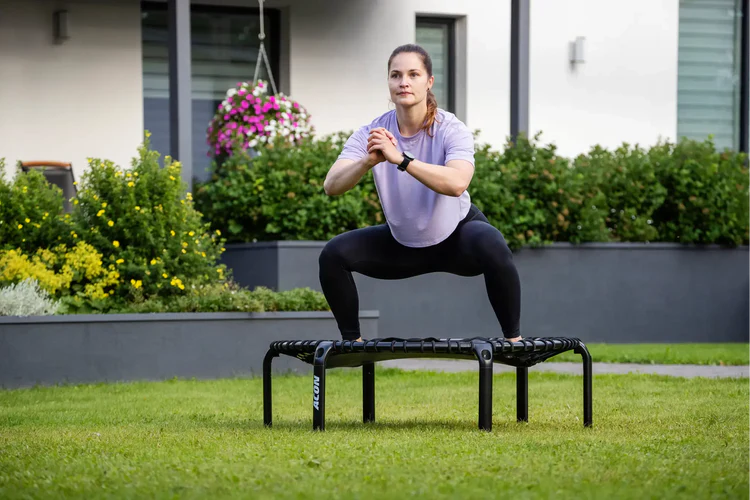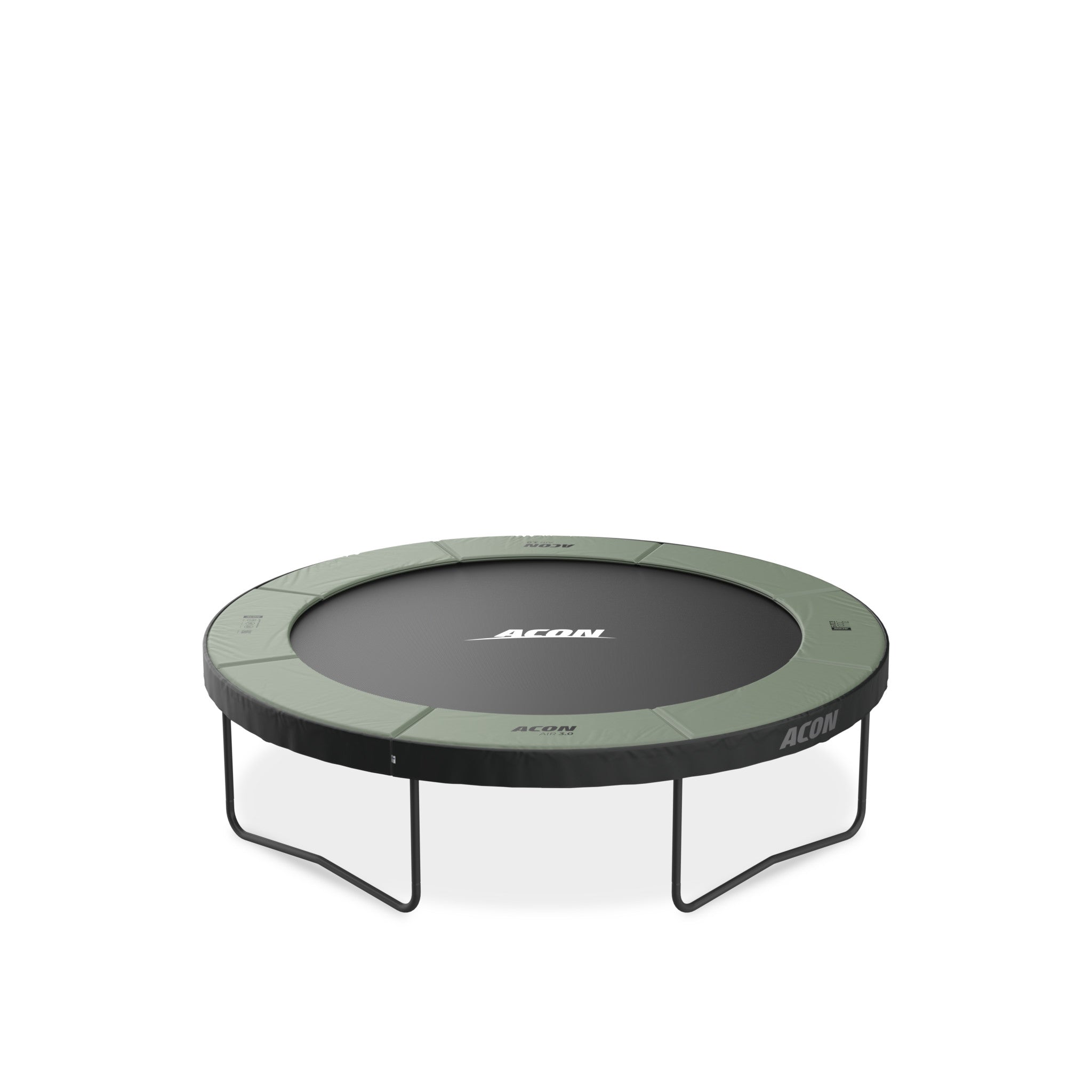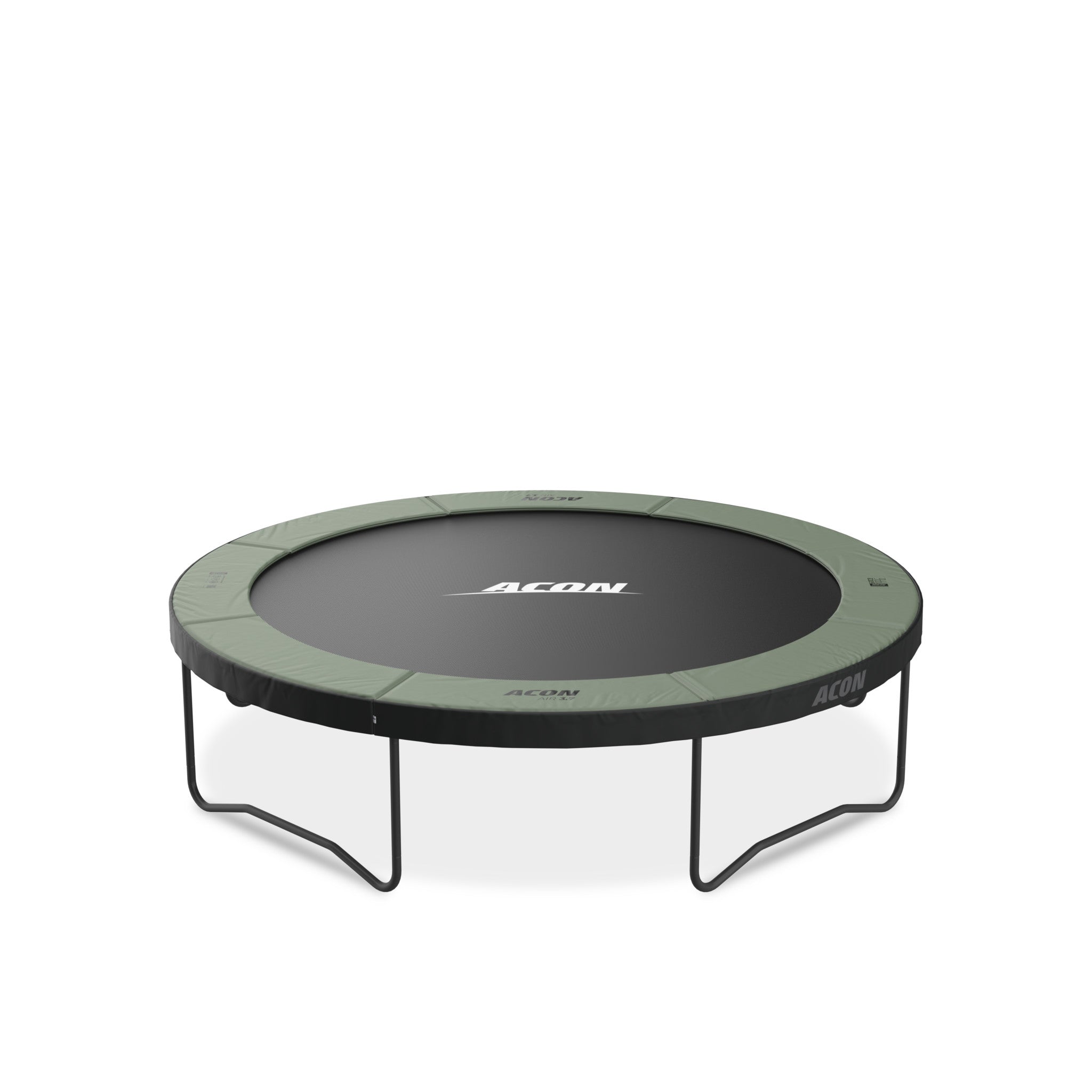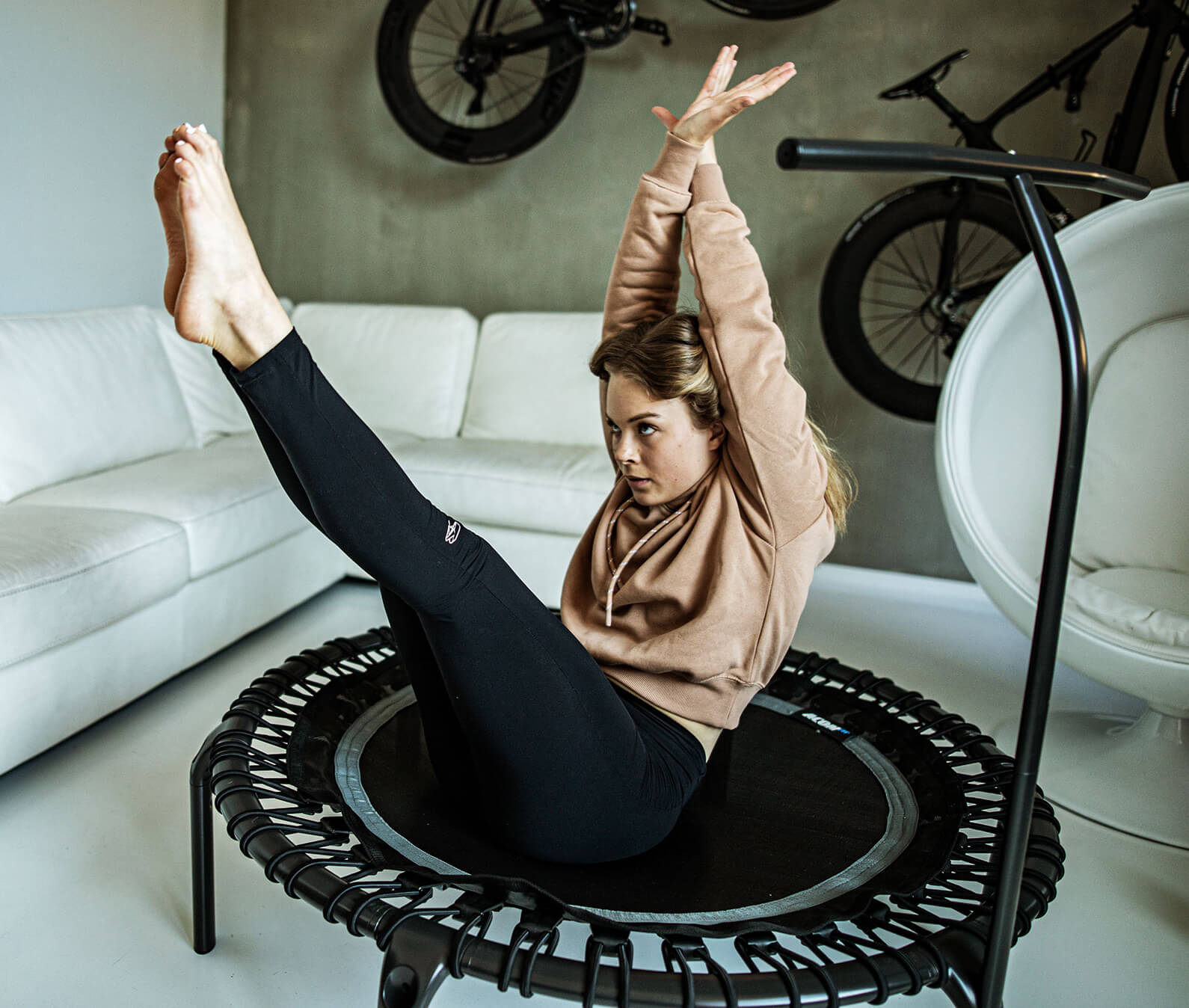Distributacon Inc.
1250 Wayzata Blvd E Unit 1127,
Wayzata, MN 55391, USA
A full-body workout, jumping on a trampoline engages your core, legs, and arms. The benefits of these exercises aren’t limited to the more obvious, desirable outcomes of improved balance and coordination; they also encourage the release of endorphins, which help to reduce stress and boost your mood.
It doesn’t matter if you’re a beginner or a more experienced enthusiast: trampoline exercises can be tailored to meet your exercise goals. By adjusting the movements to match your fitness level, you’ll be enjoying the thrill of the bounce – and growing your fitness – in no time!
These movements are easy to practice, whether during a home workout routine or at the gym. They’re not only convenient, but also accessible for most people, so there really is no excuse: it’s time to get jumping!
Key Takeaways
- Improve your fitness the fun way, regardless of your age or level when you begin.
- Enjoy a low-impact workout that improves cardiovascular health, builds strength, and increases flexibility.
- Watch your fitness levels grow and benefit from better overall health.
Benefits of Trampoline Exercise
Everyone can benefit from adding trampoline exercises to their workout routine. Here are some of the main reasons why:
Improved Cardiovascular Health
Jumping on a trampoline is a great way to get your heart rate up. While boosting your heart rate and a greater oxygen intake is required, which helps to improve your overall fitness levels. Increasing your heart rate with exercise helps to build stamina, as it takes more effort for your heart to pump blood around the body. In turn, this helps to strengthen and improve your cardiovascular health. Better cardiovascular health is associated with a reduced the risk of heart disease.
Muscle Toning
Trampoline exercise is an effective way to tone your muscles. It provides a full-body workout that targets multiple muscle groups simultaneously, including your legs, core, glutes and arms. When you jump on a trampoline, you engage your leg muscles to propel yourself upwards, while at the same time, your core and glutes must maintain balance and stability. This can help you to build strength and tone your muscles over time.
Joint-Friendly Workouts
Trampoline exercises are low-impact, and by extension, gentle on your joints. Many fitness enthusiasts use rebounders as a way to get a high-intensity workout while minimizing joint strain. Unlike running or other high-impact exercises, trampoline exercise reduces the stress on your joints and can help to prevent injuries.

Getting Started with Trampoline Exercises
It might sound obvious, but always make sure to warm up before you start jumping. Warming up prepares your muscles for exercise, which in turn helps to prevent any unwanted injuries.
Warm-Up Routines
Here is a simple warm-up routine to try before your next trampoline workout:
- Jog in place for 2-3 minutes to get your heart rate up.
- Do some light stretching, focusing on your legs, back, and arms.
- Beginning with basic bounces, jump on the trampoline for 5-10 minutes, before gradually increasing the intensity.
Trampoline Workouts for Beginners
If you are new to trampolining, basic exercises are your friends. Why? They’ll get you started, while helping to make sure you avoid injuries as you build strength and endurance.
Simple Bounce
The simple bounce is an excellent place to start for beginners. It involves basic jumping techniques, such as:
- Basic Bounce: This involves jumping with your feet shoulder-width apart, keeping your arms by your side, and landing on the trampoline with both feet at the same time.
- Tuck Jump: This involves jumping with your feet shoulder-width apart and bringing your knees up towards your chest as you jump.
- Straddle Jump: This involves jumping with your feet shoulder-width apart and spreading your legs apart as you jump.
You can do each of these jumps for 30 seconds or more, depending on your fitness level. As you progress, you can increase the intensity by jumping higher or adding arm movements.
Balance and Stability Drills
The balance and stability drills are essential for beginners, as they help to improve your coordination levels. For example, you can try:
- Single Leg Balance: Stand on one leg and lift the other leg off the trampoline. Hold this position for a few seconds before switching legs.
- Squat Jump: Squat down and jump up as high as you can while keeping your balance.
- Twist Jump: Jump and twist your body to the left or right while in the air.
As you hone your balance and stability, these exercises also work your core muscles. Practice each exercise for 30 seconds or more, depending on your fitness level.
Featured Trampolines
Senior Beginner Trampoline Routines
Specifically tailored to accommodate the needs of older individuals, exercises for seniors who are new to trampolining emphasize low-impact movements, stability, and control. They help to ensure a safe trampolining experience that seniors can enjoy from the get-go. By creating positive associations with the trampoline, you’re more likely to look forward to your time on there! This is important when beginning something new, as even the most simple exercises can pose a challenge. But fear not, these enjoyable exercises are designed to improve mobility, strength, and balance over time—while minimizing the risk of strain or injury.
- Trampoline Walking: Simply walk in place on the trampoline surface, focusing on maintaining balance and stability. This low-impact exercise helps seniors get comfortable with the trampoline's movement and improves leg strength.
- Trampoline Side Steps: Stand on the trampoline and take small steps from side to side, focusing on maintaining balance and stability. This exercise helps improve lateral movement and strengthens the lower body muscles.
- Trampoline Seated Bounces: Sit on the trampoline and gently bounce up and down, focusing on maintaining stability and control. Seated bounces allow you to get familiar with experiencing the trampoline's bounce, while improving core strength.
Fun Trampoline Exercises for All Fitness Levels
These very simple trampoline exercises are suitable for beginners of all age levels and provide a gentle introduction to trampolining while improving balance, coordination, and overall fitness. Many winter exercises, such as skiing and snowboarding, are weather dependent; however, bouncing on a trampoline in the crisp winter air can offer a refreshing way to stay healthy in colder months. It's also a wonderful a way for the whole family to bond and enjoy shared experiences, by exercising together.
- Jumping Jacks: Start with small, controlled jumping jacks to get used to the trampoline's bounce. Focus on maintaining balance and gradually increase the size of the jumps as you progress.
- Squat Jumps: Perform shallow squat jumps, focusing on the squatting motion and a gentle push-off from the trampoline surface. As you gain confidence, gradually increase the depth of the squat and the height of the jump.
- Butt Kicker Jumps: Start with small butt kicker jumps, bringing your heels toward your glutes with control. Focus on maintaining stability and gradually increase the intensity and height of the kicks as you become more comfortable with the movement.
- Twists: Start with small twists from side to side, focusing on controlled movements. As you become more comfortable, increase the range of motion and speed of the twists.
- Single-Leg Bounces: Begin with gentle bounces on one leg, focusing on maintaining balance and stability. Switch to the other leg and repeat.
- Jogging Variations: Start with a gentle jog in place, focusing on maintaining a steady pace and controlled movements. Gradually increase the intensity and speed of the jog as you get used to the feel of the trampoline's bounce.
- Regular Jogging: Perform a controlled and steady jog on the trampoline surface, focusing on maintaining balance and stability. As your balance improves, work on increasing the duration and intensity of the jog.
- Vertical Jumps: Start with small, controlled vertical jumps, focusing on a gentle push-off and controlled landing. To make this harder, focus on increasing the height and power of the jumps.
Conclusion
Using a trampoline offers a number of benefits for overall health. Not only is trampolining a fun form of exercise, it’s an excellent way to burn calories that helps with weight loss too. Trampolining is gentle on the joints, reducing the risk of impact-related injuries while still providing an effective workout. Besides its positive effects on cardiovascular health, coordination, and balance, the rhythmic bouncing motion on a trampoline can be a great stress-reliever, promoting mental well-being and reducing anxiety.
Safety tips
Choosing the right trampoline is crucial for safety. Look for trampolines with sturdy frames, high-quality springs, and adequate safety features such as enclosures and padding. Additionally, consider the size of the trampoline and ensure it fits the available space and is suitable for all its users.
Use safety padding for garden and non-rebounder trampolines to cover the springs, frame, and hooks, reducing the risk of injury. Make sure you regularly inspect the trampoline for any signs of wear and tear, and replace any damaged parts. Consider the weight limit of the trampoline, making sure it’s not exceeded, and supervise trampoline usage, for the best safety outcomes.
By following these guidelines and choosing a suitable trampoline, you can fully (and safely!) enjoy the many health benefits and improvements to overall well-being that are offered by regular trampolining.
Frequently Asked Questions
Does jumping on a trampoline count as exercise?
It might not feel like it because you’re having such a great time, but…yes! Jumping on a trampoline counts as exercise. It can be an effective way to improve cardiovascular fitness, strengthen muscles, and enhance balance and coordination.
Is the trampoline worth it for fitness?
The trampoline can be worth it for fitness, as it offers a fun and engaging way to get a full-body workout. It can be particularly beneficial for individuals who enjoy low-impact exercises and want to add variety to their fitness routine.
Is trampoline a full body workout?
Trampolining can provide a full-body workout, as it engages various muscle groups, including the legs, core, and arms. The bouncing movement also helps improve cardiovascular fitness and contributing to overall physical health.
What are the benefits of using a mini trampoline for adult fitness routines?
Using a mini trampoline can help to improve cardiovascular health, increase muscle tone and strength, and improve balance and coordination. It is a low-impact exercise that is easy on the joints, making it accessible for everyone.
How does trampoline exercise intensity compare to traditional cardio workouts?
Trampoline exercise can offer the same intensity as traditional cardio workouts like running or cycling. Its low-impact nature makes it gentler on the joints, providing an excellent alternative for those seeking a joint-friendly exercise.
What safety precautions should be taken when engaging in trampoline exercises for fitness?
Before you start, always ensure your trampoline is in good condition and set up on a flat, level surface. Wear appropriate footwear and clothing, and avoid exercises beyond your current skill level. Begin with a few minutes a day and gradually increase your workout time as your skills improve.
Disclaimer: A trampoline is not a medical device, and the information provided here is not intended as medical advice. Please consult your doctor for any medical concerns or advice before beginning any new exercise routine. Always prioritize your health and safety.













